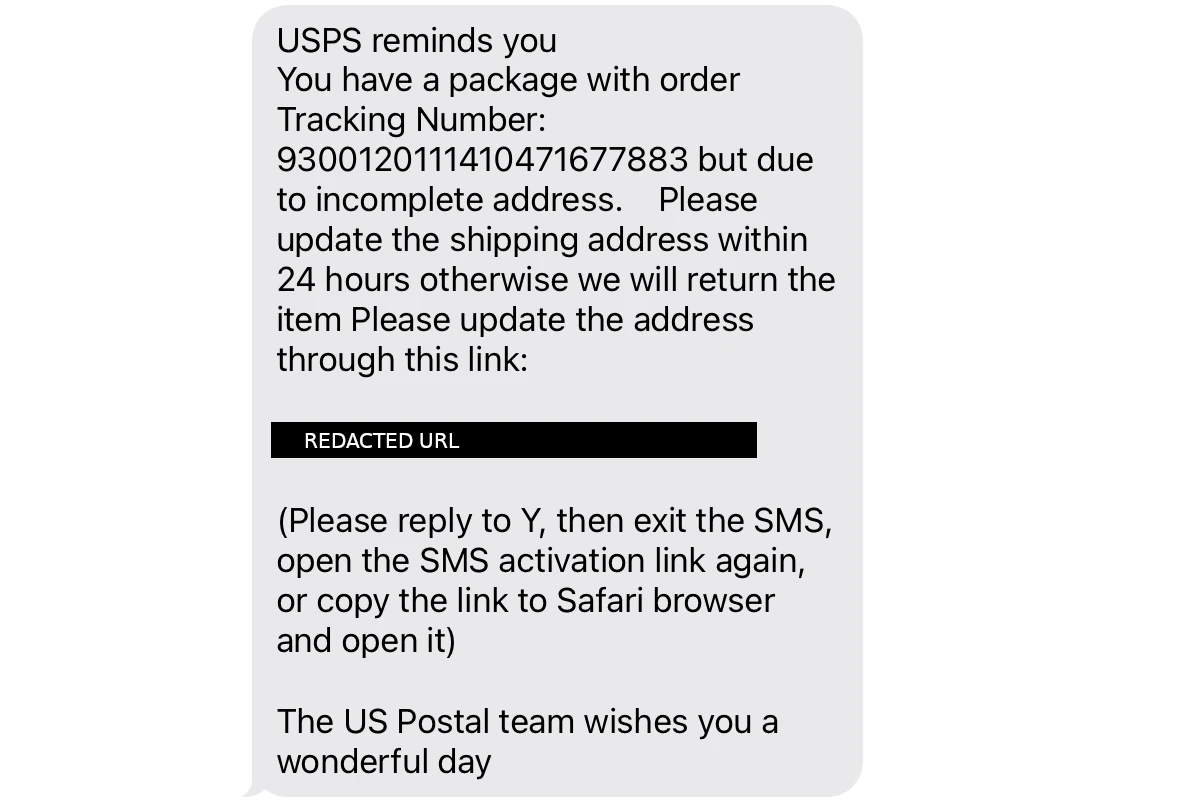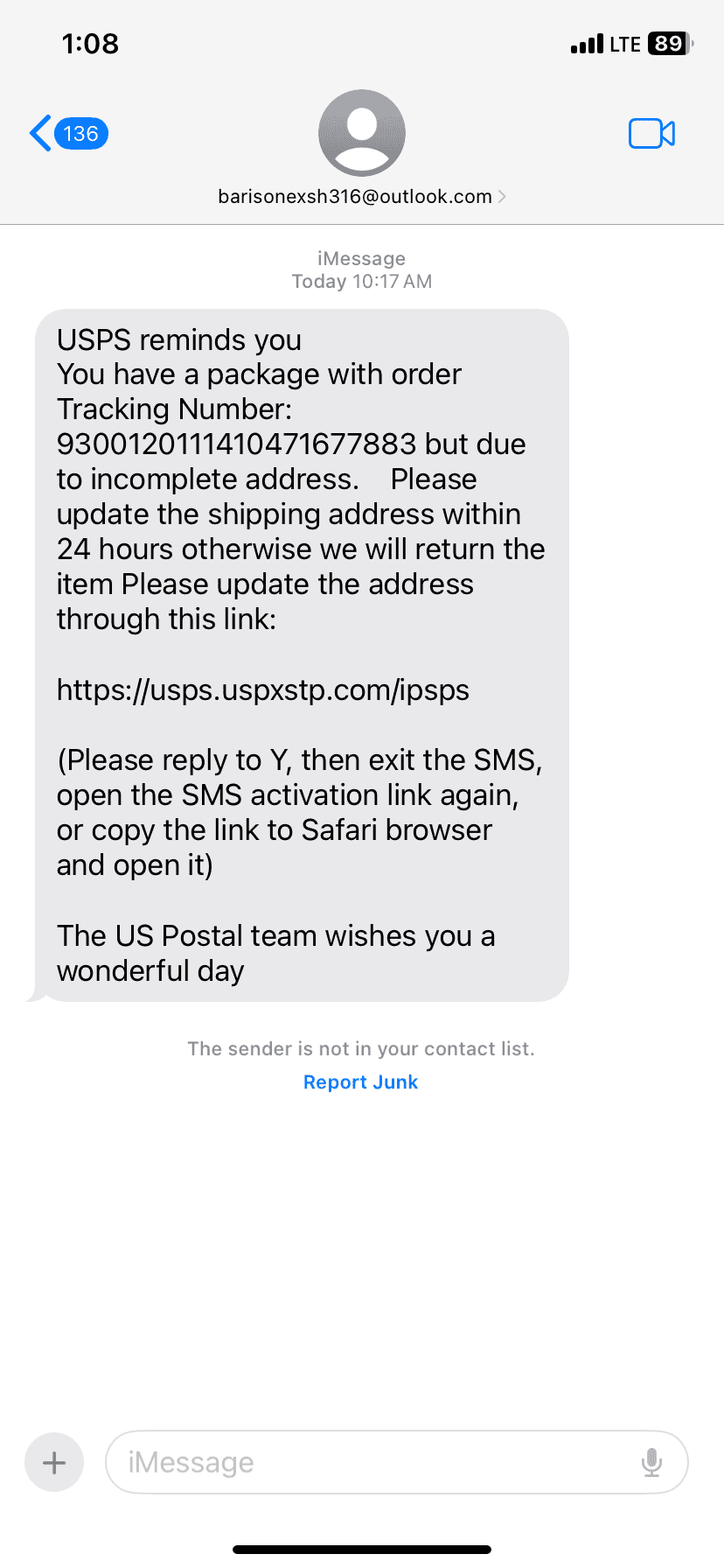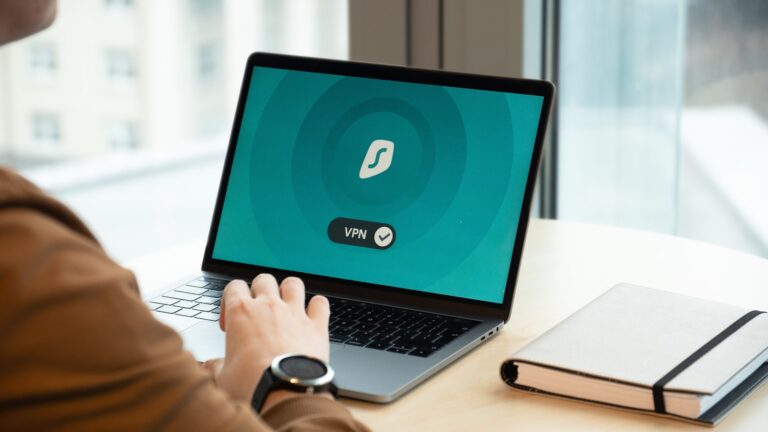
A new scam is making the rounds that says you have a package that can’t be dlivered due to an incomplete address. It’s important if you receive this message to not click on any links, don’t respond to the message, and simply mark it as SPAM (Report Junk). The message uses a fake USPS tracking number to trick people and misrepresents who the message is from. Usually the scam claims there’s a problem with your package address and asks you to click a link but sometimes they will also try to get you to message back and forth first before getting to that point.
These texts look real. They say your package can’t be delivered due to an incomplete address. They want you to enter personal info or pay a fee. But it’s all fake.
The goal is to steal your data or money. Scammers use the USPS name to seem trustworthy. They hope you’ll act fast without thinking. But knowing how it works can help you stay safe.

Beware: USPS Scam Texts on the Rise
Don’t Fall for Fake Delivery Notifications
Scammers are increasingly targeting individuals with fraudulent text messages that appear to be from the United States Postal Service (USPS). These texts often claim there’s an issue with a package delivery and prompt you to click a link or provide personal information to resolve it.
Sample Scam Message Text
USPS reminds you
You have a package with order Tracking Number: 9300120111410471677883 but due to incomplete address. Please update the shipping address within 24 hours otherwise we will return the item Please update the address through this link:[REDACTED LINK on Domain uspxstp.com]
(Please reply to Y, then exit the SMS, open the SMS activation link again, or copy the link to Safari browser and open it)
The US Postal team wishes you a wonderful day.
Red Flags to Watch Out For
- Unexpected messages: If you haven’t recently shipped or ordered a package, be wary of any unexpected texts claiming to be from USPS.
- Suspicious links: Never click on links in unsolicited texts, especially if they lead to unfamiliar websites.
- Requests for personal information: The USPS will never ask for your personal or financial information via text message.
- Urgent language: Scammers often use urgent language to pressure you into taking immediate action.
- Grammatical errors and typos: Be suspicious of texts with poor grammar or spelling mistakes, as these are often signs of a scam.
How to Protect Yourself
- Verify the sender: Double-check the sender’s phone number or email address. If it doesn’t match official USPS communication channels, it’s likely a scam.
- Contact USPS directly: If you’re unsure about a text message, contact the USPS directly through their official website or customer service number to verify its legitimacy.
- Report suspicious messages: Report any suspected scam texts to the USPS and your wireless carrier.
- Never share personal information: Never provide your personal or financial information in response to an unsolicited text message.
- Install security software: Consider installing anti-malware and anti-phishing software on your devices to help protect against scams.

Stay Vigilant
Remember, scammers are constantly evolving their tactics. Always be cautious when receiving unexpected text messages, even if they appear to be from a trusted source like the USPS. By staying vigilant and following these tips, you can protect yourself from falling victim to these scams.
Key Takeaways
- Fake USPS texts about incomplete addresses are a common scam
- Never click links or share personal info from unexpected texts
- Report suspicious USPS messages to help stop scammers
Understanding Phishing and Smishing
Phishing and smishing are two common types of online scams. They aim to trick people into giving away personal data. Scammers often pretend to be trusted companies or groups.
The Mechanism of Phishing Scams
Phishing scams try to get private info through fake emails or websites. They often copy real company logos and designs. The goal is to make victims think the message is real.
Scammers might ask for:
• Passwords
• Bank details
• Social Security numbers
They may claim there’s an account problem or a prize to collect. Some phishing emails have links to fake login pages. These pages can steal entered info or install malware.
Phishing attacks can lead to identity theft and financial losses. Scammers might use stolen data to open credit cards or take out loans in the victim’s name.
Smishing: Phishing Via SMS
Smishing is like phishing but uses text messages instead of email. It stands for “SMS phishing.” Scammers send texts that seem to be from banks, stores, or shipping companies.
A typical smishing text might say there’s a problem with a delivery. It asks the reader to click a link to fix the issue. This link often leads to a fake site that steals info.
USPS smishing scams are common. They claim a package can’t be delivered due to a bad address. The text urges victims to “verify” their details through a link.
To stay safe, don’t click links in unexpected texts. Check with the real company directly if you’re not sure about a message.
The Anatomy of a USPS Incomplete Address Scam
USPS text scams use fake messages and websites to trick people. They try to get your personal info by pretending there’s a package problem.
Identifying Fraudulent Messaging
Scam texts often claim a USPS package can’t be delivered due to an incomplete address. They ask you to confirm your address through a link. These messages may look real at first glance.
The texts create a sense of urgency. They might say you only have a short time to respond. This pushes people to act quickly without thinking.
Scammers use different phone numbers for these texts. The numbers often change to avoid being blocked.
The Role of Fake USPS Branding
Scammers copy USPS logos and colors on fake websites. This makes them look real to unsuspecting victims.
The fake sites may have USPS-like web addresses. They might use slight misspellings or add extra words to fool people.
These websites ask for personal info like:
- Full name
- Address
- Phone number
- Credit card details
Immediate Red Flags
Real USPS messages don’t ask for personal info via text. They also don’t demand quick action for delivery issues.
Be wary of links in unexpected texts. Hover over links to see the real web address without clicking.
Look for spelling mistakes or odd wording in messages. Official USPS texts are clear and well-written.
Check the sender’s number. USPS uses specific short codes for text alerts. Random phone numbers are a big warning sign.
Protective Measures Against Scams
Protecting yourself from USPS text message scams requires smart online habits. Strong cybersecurity, using official channels, and careful digital communication can keep you safe.
Enhancing Personal Cybersecurity
Use strong passwords for all your accounts. Don’t use the same password twice. Turn on two-factor authentication when you can. This adds an extra layer of security.
Keep your devices updated. Install the latest software and security patches. Use antivirus software and keep it current.
Be careful about clicking links in texts or emails. When in doubt, go directly to the official website instead.
Check your accounts often. Look for strange activity. If you see something odd, tell your bank right away.
Official Channels for Address Verification
Always use the real USPS website or app to check on packages. The official site is www.usps.com. Don’t trust links in texts or emails.
If you’re not sure about a message, call USPS directly. Use the phone number from their official website.
USPS won’t ask for personal info or payments by text. If a message asks for these, it’s likely a scam.
Safe Practices in Digital Communication
Be wary of urgent messages. Scammers often try to rush you into action. Take your time to check things out.
Don’t give out personal info in texts or emails. This includes your address, Social Security number, or bank details.
If a deal seems too good to be true, it probably is. Be careful with amazing offers, especially from unknown senders.
Report scams to the FTC. This helps them fight fraud and warn others. You can report scams at ftc.gov/complaint.
Frequently Asked Questions
The USPS text message scam tricks people with fake delivery problems. Scammers try to steal personal info and money through these texts.
How does the USPS text message scam involving incomplete addresses typically work?
Scammers send texts claiming to be from USPS. The message says a package can’t be delivered due to an incomplete address. It asks the person to click a link and confirm their address.
The link goes to a fake USPS website. This site asks for personal details like name and phone number. Some even ask for payment to “fix” the delivery issue.
What are the common indicators of a USPS scam text message?
Scam texts often have spelling mistakes. They may use urgent language to make people act fast. The sender’s number is usually unfamiliar.
These texts always include a link. Real USPS messages don’t ask for personal info or payments through texts.
What should recipients do if they receive a suspicious text message claiming to be from USPS?
Don’t click any links in the text. Delete the message right away. Never give out personal info or payment details in response to these texts.
If unsure, contact USPS directly using their official website or phone number. Report the scam text to USPS and your phone company.
How can consumers verify the authenticity of a USPS notification?
Check the official USPS website for tracking info. Use only the tracking number, not links from texts. Call USPS customer service with questions.
Look up the sender’s phone number online. Real USPS texts come from known numbers. Be wary of texts from random numbers claiming to be USPS.
What steps has USPS taken to combat text message scams?
USPS warns customers about these scams on their website. They provide tips to spot fake messages. USPS works with law enforcement to stop scammers.
The postal service never asks for personal info or payments via text. They encourage people to report scam attempts.
How can USPS customers protect their personal information from text message phishing attempts?
Be careful with unexpected texts about deliveries. Don’t click links or download attachments from unknown senders. Use official USPS contact methods to check package status.
Keep phone security updated. Use spam filters when possible. Learn about common scam tactics to spot them easily.






